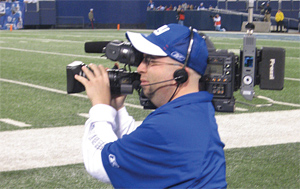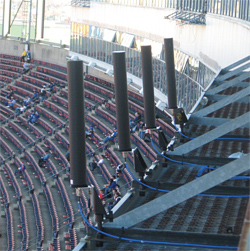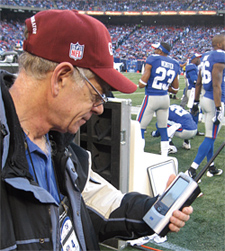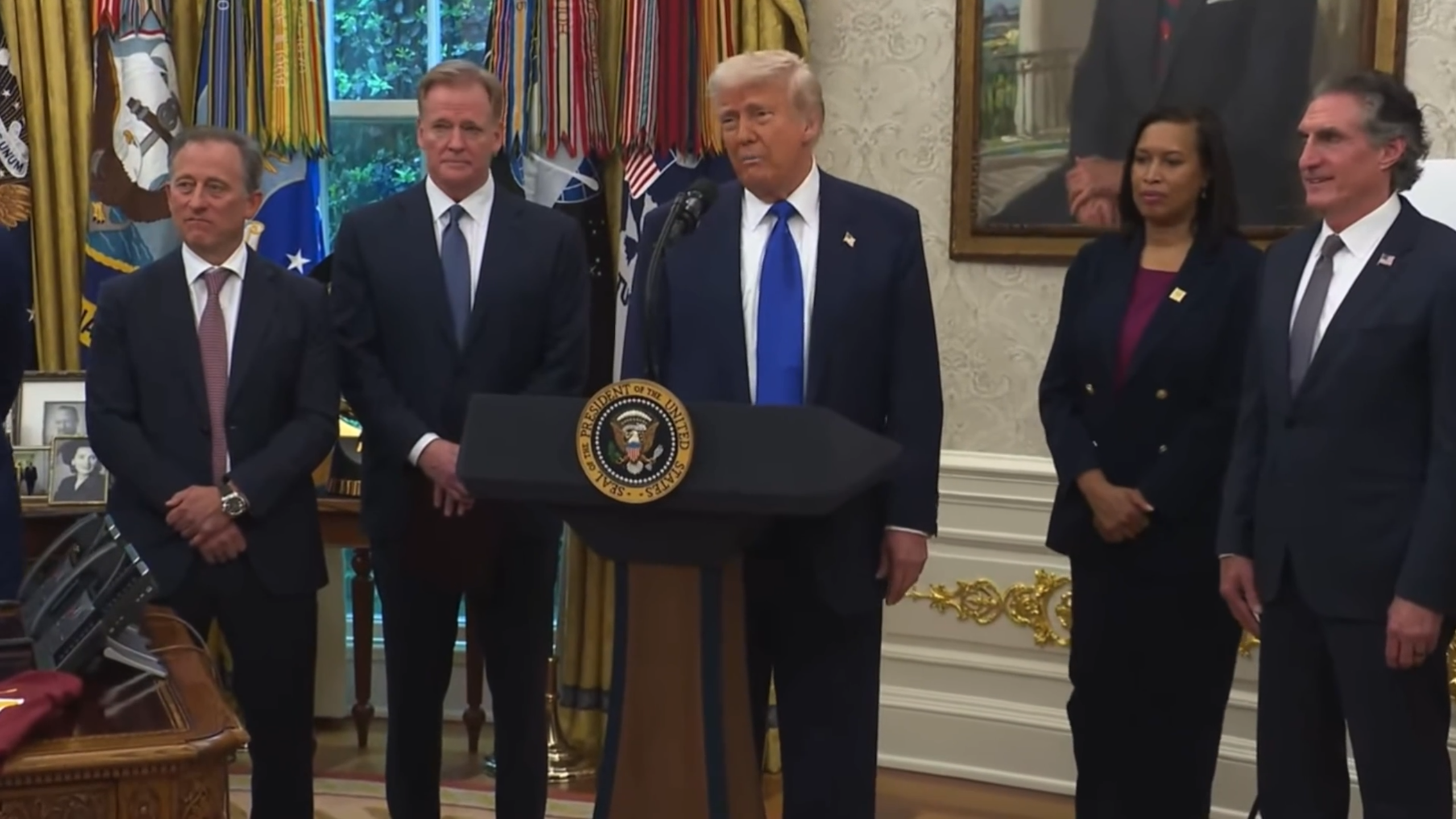NFL Finds the Right Frequency
NEW YORK
Rich Carlino and company have cut the cord—well, unplugged it, rolled it up and put it away, anyway—with marvelous results.
Carlino is director of multimedia event productions for the New Jersey Sports & Exposition Authority (NJSEA), which handles the in-house video operations at Giants Stadium, the home of the National Football League's (NFL) New York Giants, New York Jets and the New York Red Bulls of Major League Soccer; and the adjacent Izod Center, the home of the National Basketball Association's New Jersey Nets.

Cameraman Kris Kmie with the Nucomm CP2 transmitter, mounted on a Panasonic DVCPRO camcorder. What has Carlino and his colleagues at the NJSEA juiced is the use of the Nucomm CP2 Camera Mounted Transmitter and DR2 Diversity Receiver, which allows in-house camera operators at Giants Stadium and elsewhere in the sports universe to work as a solo act—which has greatly enhanced the content and the reliability of the signal during acquisition for the video boards during events.
No longer is the cameraman trailed by a stickman with a transmitter, and thus is no longer encumbered; the shooter can basically roam anywhere within or around a massive sports complex to garner content that accentuates the game presentation.
Counting the CP2 and the CMT2 systems, RF Extreme has sold Nucomm products to more than two dozen professional and college venues across the country, said Anthony Sangiovanni, vice president, sports and entertainment for RF Extreme (a division of The Vitec Group).
"We have many more systems in the pipeline now and have recently sold to the [NFL's] Buffalo Bills and [MLB's] Minnesota Twins," Sangiovanni said. "With the economy improving, I see more growth coming in this market, especially at the collegiate level."
STABILITY IS KEY
What the CP2 means to an in-house broadcast team is freedom, as well as reliability. "We can now go places we've never gone before: the lobby, the concourse, in front of the locker room area, into the seats or anywhere in the bowl," said Joe Schilp, the senior video production specialist for the NJSEA, "whether it's in the line of sight of the control room or not."

A side view of the four RF Extreme antennas, mounted at four-foot intervals on the ledge outside the control room. The differentiating factor is the transmitter being connected to the Panasonic DVCPRO AJ-D700AP camera, making for a smaller, lighter, self-contained unit.
The old setup also "caused problems with the signal breaking up and freezing, aside from dealing with a 13-foot 'umbilical cord' of sorts. There was a failure of some sort during almost every game," said Alexander Pla, a video production specialist with the NJSEA, who noted the occasional use of a laser pointer to ensure that there was a direct line of sight between the two-man crew on the field and the video control room.
The connection to the control room in the press box at Giants Stadium is made via four Diversity antennas that are located (at four-foot intervals) on the metal ledge in front of the booth. They run to a DR2 signal receiver in the control room that is the size of a portable CD player.
"This is the third or fourth system we've used in the complex," said Carlino. "Without it, we simply could not offer the variety of content that we offer now."
Not only has the new system meant increased opportunities to obtain previously unavailable shots, it has also enhanced the marketing opportunities for in-game promotion.
"If you're working with a sponsor, now you can visit a pizza stand, for instance, and shoot," said Carlino. "Before, we had to record the footage then play it back to acquire content because we never knew when a live shot would break up or freeze on us. So employing the [Nucomm technology] has meant peace of mind and saved us time on our end."
Just how big has this technical advance been? "The most oft-used word in the control room has always been 'stabilize,'" said Pla. "Not anymore."
RF CROSSING
While the use of RF Central's transmitter has provided a big boost to the artistic and marketing efforts of the NJSEA video crew, it has also required a sliver of space in New York's cluttered broadcast spectrum.

Steve Mendelsohn, game day frequency coordinator for the NFL. The NFL works to ensure space for all by employing frequency coordinators at all NFL games to keep the spectrum's various inhabitants from overlapping each other's signals.
"The New York market is a very RF-congested area," said Don Sperling, vice president and executive producer of Giants Entertainment, "given the number of broadcast outlets here, plus the number of airports and various companies that do business here."
Just how tight is Gotham's RF market? Steve Mendelsohn, who serves as a game day frequency coordinator at Giants Stadium (primarily for the New York Jets and occasionally for the cohabitant Giants), made the analogy that he "parks about 130 cars in a lot built for 50, so to speak" for each game.
What happens at field level makes the spectrum even tighter. "Stop and consider," said Mendelsohn, "that each coach on the field has a beltpack with four frequencies per pack, with about 10 coaches per team. Then the quarterbacks have two per pack. That's 42 frequencies for each team right there; so with two teams, that's about 84 frequencies."
But that's hardly all. "Then add another 15 frequencies for the referees, the chain gang and security frequencies. That's 99 — before counting the TV broadcasters, which require 40 frequencies each, minimum," he said. "Then there are another 15 for home and away radio, and 20 more for various broadcasters doing stand-ups before and after the game.
"And what most people forget about is," Mendelsohn said, "that all of this RF is basically contained within and around just 100 yards."
CASTING AN EYE
It turns out that Mendelsohn's "eye in the sky" is none other than his wife, Heidi Mendelsohn, who oversees the spectrum analyzer in the press box to ensure that the frequencies of the broadcast media and the various other aforementioned entities don't interfere with those of the coaches' frequencies.
"She watches everything and we accommodate everyone with a little bit of 'guard room' on the white space, and that allows everyone to operate without interference," Mendelsohn said, "and to make sure that no one is where they are not supposed to be, including the state police, the FBI or the Secret Service."
And watching "everything" is what today's viewers, most of whom grew up watching sports on TV and can now do likewise by holding an electronic device in the palm of their hand, want today—even when they're attending the game.
"Fans are very sophisticated today," said Sangiovanni. "They have higher expectations from the venues for the total experience and wireless cameras allow the game producers like Rich to bring the game that much closer to them."
Get the TV Tech Newsletter
The professional video industry's #1 source for news, trends and product and tech information. Sign up below.
